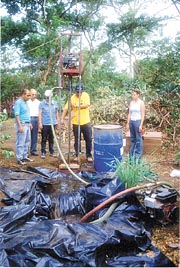
Americans use twice the worldwide average, about 150 gallons per day for domestic use (450 total, including agricultural and industrial), compared with 7.5 gallons per day for Africans on the other end of the spectrum. At least two-thirds of the world's population must haul their water from outside the home. In some cases, women must walk many miles and spend several hours each day hauling water on their heads, in containers that can weigh more than 40 pounds. It is estimated that the minimum amount of safe water required to keep one person healthy (for drinking, bathing, cooking and sanitation) is 5 gallons per day. But when water is hauled by such great effort over long distances, some people get by with as little as one and a half. This also is water not available to raise vegetables to improve nutrition, raise animals or undertake small business ventures. Women who invest large amounts of time for water hauling have less time for their families, and the children have no time for school. Without water for cash crops, husbands and fathers must go to the cities in search of work, adding more stress to the family and community.
Conservative estimates put the number of people living under moderate water stress as one-third of the earth's population, with another half billion or more enduring severe stress. With another 3 billion to 6 billion people projected to be added to the planet by 2050, and per capita water demand rising twice as fast as population, one does not have to be a math wizard to understand that this is a serious issue. Added to the unsustainable rate in which we are using water already, the surface waters and aquifers that are left are being fast polluted by human and animal feces, agrichemicals and industrial waste. With surface waters, aquifers and watersheds often shared by several countries, and global water resources unevenly distributed, competition for this precious resource is becoming fierce, with a high potential to escalate into conflict.
The Water for Humanity (WFH) Fund is a non-sectarian organization dedicated to doing its part to alleviate these problems. Established in 1991, its stated mission is to provide adequate supplies of safe and potable water throughout the developing world and areas of natural disaster. To date, the WFH Fund has conducted successful projects in 12 countries throughout the Americas, the Caribbean, Africa and Asia.
The Water for Humanity has a nine-member all-voluntary committee, whose objective is funding the development of safe, reliable and adequate water resources. These usually are in the form of drilled and hygienically sealed wells. On occasion, we also have funded the digging of open wells, capitation of spring water sources, the use of rainwater catchments, and building of water filtration devices. Several members also have procured funding from other sources to travel to Central America, the Caribbean and Africa to supervise projects themselves. Our members traveling abroad have trained dowsers and dowsed water well sites, instructed in the operation and maintenance of portable drilling equipment, and assisted in the selection of manual pumping technology. They also have taught how to build composting latrines, given courses in grant proposal writing, and supervised the building of slow-sand water filtration devices.
In considering proposals that have been submitted to the WFH Fund, the committee uses a strict set of criteria by which we judge these. First, they must submit proof of being a legitimately registered society, and when applicable, also registered to receive foreign contributions. We look for a professionally prepared proposal, introducing the organization and its situation, describing the project and its activities, and providing an itemized budget with various attachments. The committee assesses whether there is true need that is supported by evidence. Typically, the situation is described as drought conditions, dropping water tables, contaminated surface supplies, long distances to current supply, governmental neglect or inability to help, and caste or territorial disputes, etc. Objectives and methods must be clearly outlined. We must be assured the well will be drilled on land safe from dispute, and that the numbers of people who will directly and indirectly benefit is included.
Grants typically are in the range of $500 to $5,000, with preferences given where the greatest amount of people will benefit in the most cost-effective way. We of the WFH committee must be assured that the technology is appropriate, that is, within the capabilities of the beneficiaries to maintain and repair themselves, and that parts are readily available. To further assure the sustainability of the project, we insist that a pump maintenance organization and pump repair fund be formally established. They must outline who will mange the money and how, who will evaluate the project and how, and who will do the reporting. The proposal must give a time frame estimating the duration of the project. Lastly, we look to see how the recipients themselves are contributing, whether it be as a percentage of the monetary cost, or in-kind in the form of manual labor, transportation of materials, security, feeding and housing of workers, etc.
A quorum of members meets three times per year to conduct the Fund's business, and reports periodically to the membership. WFH honors the generosity of our contributors by maintaining a purely voluntary staff, and is proud to report that over the last three fiscal years (2000 to 2003), the percentage of total expenditures going directly to the actual well construction and other aspects of water resources development has averaged 96.3 percent. By maintaining a high degree of internal integrity, the Water for Humanity Fund has operated with great efficiency in honoring the generosity of its donors in providing this precious resource of clean water to those in vital need around the world.
ND
Report Abusive Comment